#Lauxaniid
Explore tagged Tumblr posts
Text


Photos 1-2 - Lauxaniidae sp.


Photos 3-4 - Araneidae sp.


Photos 5-6 - Orthoptera sp.


Photos 7-8 - Lepidoptera sp.


Photos 9-10 - Scarabaeidae sp.


Photos 11-12 - Prodiaphania sp.


Photos 13-14 - Geometrinae sp.


Photos 15-16 - Euomma lateralis
If the university gives me bugs and a microscope you better believe I'll take close up pics (except I couldn't identify any of them).
12/09/23 - Arthropoda spp.
QLD:CQC, Woppa (Great Keppel Island), dry woodland & sandy grassland
#invertebrates#invertblr#arthropod#arthropoda#insects#insectblr#insecta#insects tw#insect#bugs#bugblr#bugs tw#bug#entomology#Lauxaniidae#Lauxaniid Flies#Diptera#flies#Brachycera#Brachyceran Flies#Scarabaeidae#Scarabs#Coleoptera#Beetles#Lepidoptera#moths#mothblr#Orthoptera#Araneidae#Orbweavers
18 notes
·
View notes
Text
I see at least one cool bug a day, and usually many more, but it’s not because I live anywhere particularly rich in strange, wonderful creatures (I live in an unremarkable corner of Pennsylvania, USA) or spend all of my free time looking for bugs (well, just *most* of it). in my experience, finding interesting bugs is less about actually locating them and more about looking closely at tiny things you’d otherwise ignore!
this very long post was compiled over a couple days in late July, although I spent less than 10 minutes at a time searching. there’s a lot of fun creatures just out in the open.
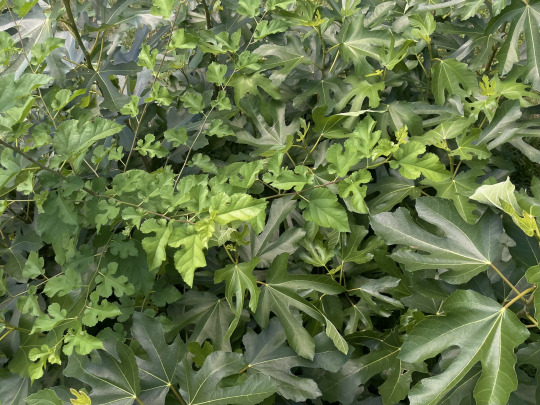
plants are always a good place to start when looking for bugs, and I chose this small fig tree (Ficus carica) with a mulberry sapling friend. feeding on the sap of the fig and mulberry is the first group I’ll take a look at, the planthoppers:

these two are flatid bugs, Metcalfa pruinosa and Flatormenis proxima. flatids are slow-moving bugs that can be approached closely, but once they get tired of circling around stems to avoid you they may launch themselves into a fluttering flight with spring-loaded rear legs.
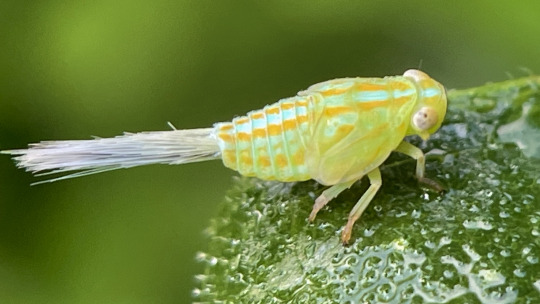
Aplos simplex, a member of the related family Issidae, also likes fig sap. its “tail” is actually a tuft of waxy secretions, which get shed along with the bright colors when it assumes a lumpy, bean-shaped adult form.
cicadellids, or leafhoppers, are just about everywhere on plants, but can be hard to approach without scaring them.
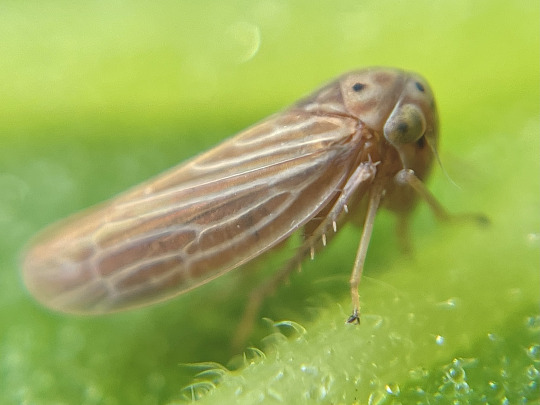
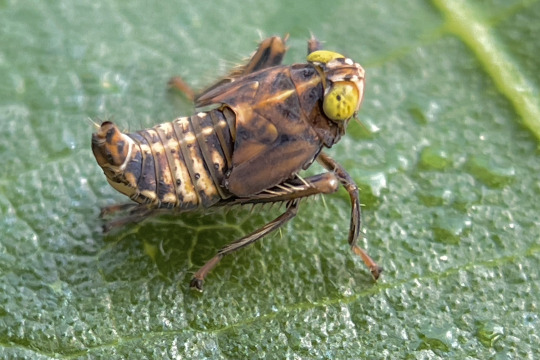
Agallia constricta on the left is a tiny species that feeds on grass, but many were scared up onto the fig by my footsteps. Jikradia olitoria is a much larger species that does feed on the fig; juveniles like this are curled, creeping goblins while adults’ rounded wings give them a pill-shaped appearance.

this big, pale leafhopper belongs to genus Gyponana. it’s tricky to get to species ID with these.
Graphocephala are striking little hoppers that eat a variety of native and nonnative plants. G. coccinea is the larger, more boldly colored one and G. versuta is smaller but more common locally. they’ll sit on the tops of leaves but take flight if you get too close quickly.

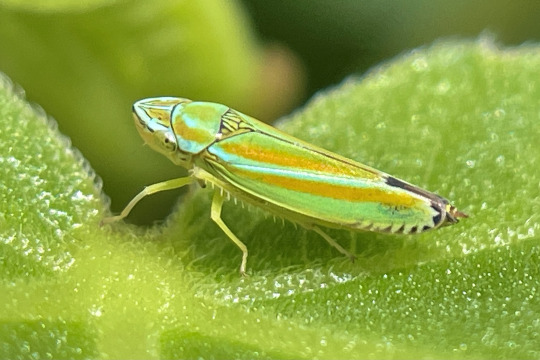
another group you’re almost guaranteed to encounter are flies (Diptera). these are a very diverse group, so much more than houseflies and mosquitoes (though I did run into both)
where I live, any plant with broad leaves is almost guaranteed to have a few Condylostylus, long-legged flies that come in shades of blue, green, and red. despite their dainty physique, they’re agile predators, typically feeding on other small flies.
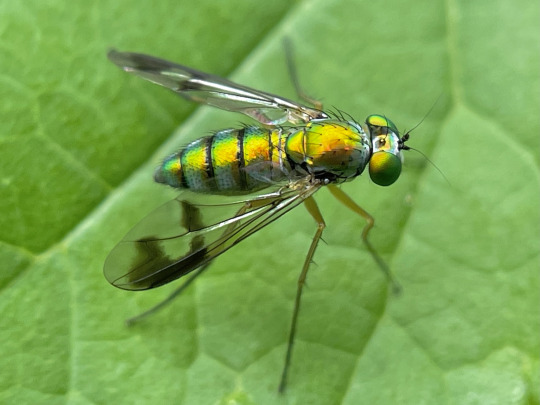
next, a few hoverflies: the ubiquitous Toxomerus geminatus and a Eumerus that I’ve been seeing a lot of this year (but maybe I’ve just noticed them for the first time). syrphids have varied life histories, but most adults drink nectar and many of the larvae are predaceous on aphids.
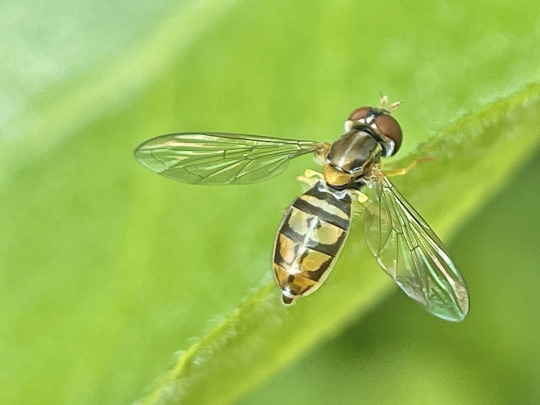
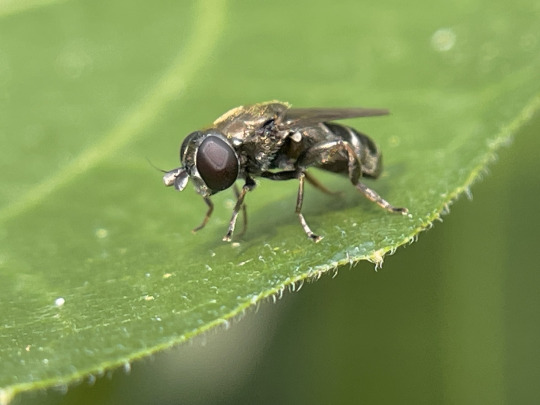
the metallic green soldier fly is Microchrysa flaviventris, nonnative here. Coenosia is a fun example of a “fly that looks like a fly,” with big red eyes and a gray body, and you might think they’re just another dung-sucking pest, but they’re actually aggressive predators! this one seemed to have nabbed itself some sort of nematoceran fly, maybe a fungus gnat.
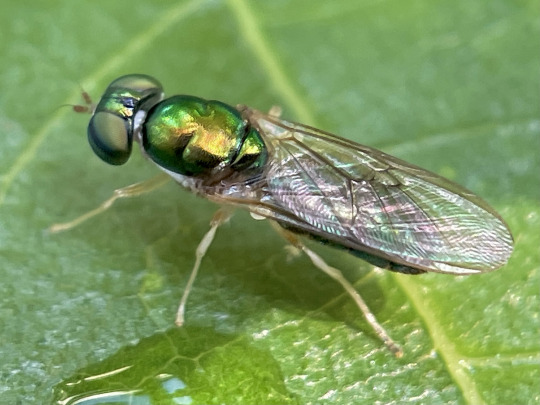
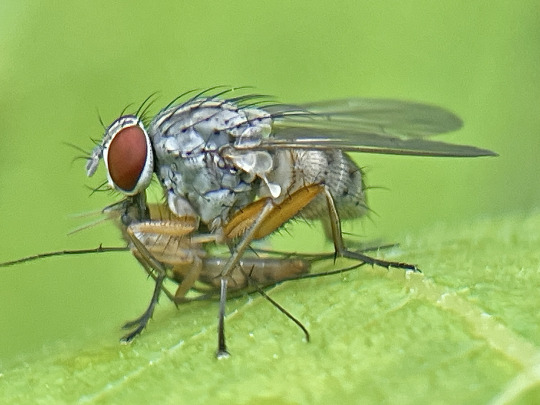
many flies are very tiny, just millimeters long. the first two little fellows are lauxaniids, while the last one, an agromyzid leafminer Cerodontha dorsalis, burrows through grass leaves as a larva.
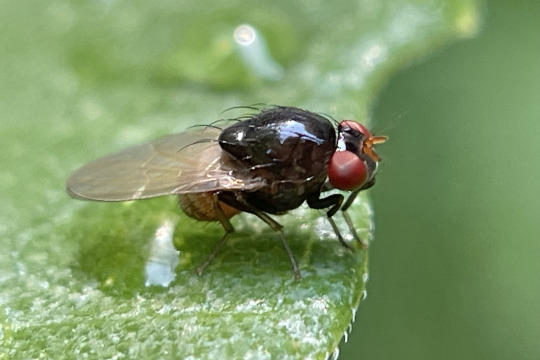
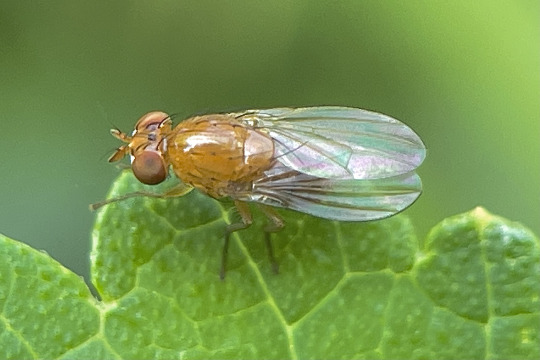
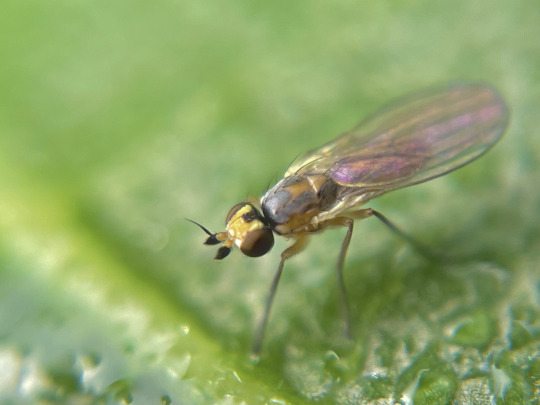
while moths and butterflies (Lepidoptera) are drawn to plants for their flowers or to lay eggs, many small moths can easily be found resting on or under leaves during the day.
these first two are tortricids, many of which are flat, rectangular moths resembling chips of bark or dead leaves. the apple bud moth, Platynota idaeusalis, feeds on a wide variety of hosts, while this beat-up old Argyrotaenia pinatubana would have developed in an edible tube nest of pine needles.

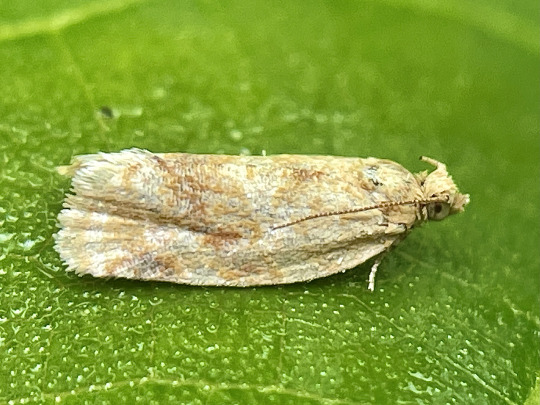
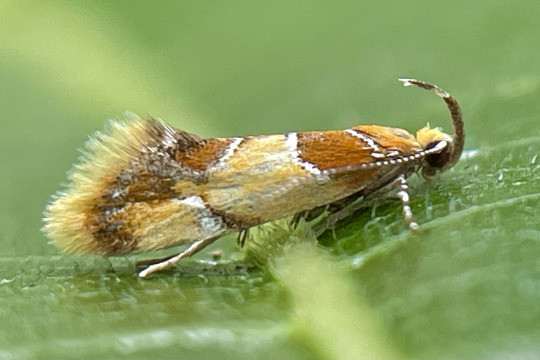

Callima argenticinctella feeds in bark and dead wood (a resource used by more caterpillars than you’d realize!) while the last moth, possibly an Aspilanta, is a leafminer.
although beetles (Coleoptera) are famous for their diversity, I didn’t find too many on the fig. the invasive Oriental beetle Exomala orientalis resting here can be found in a wide range of colors, from this common tan to to deep iridescent black. the other beetle is a Photinus pyralis firefly, sleeping under leaves as fireflies do.
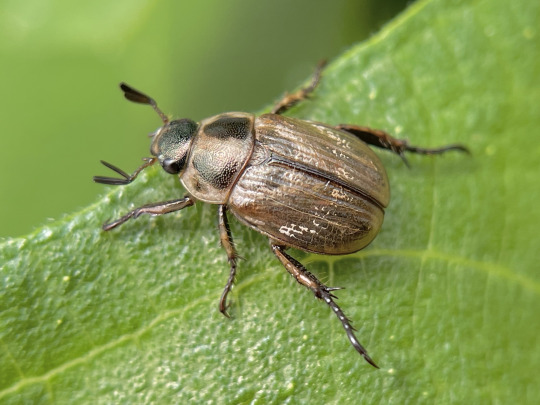
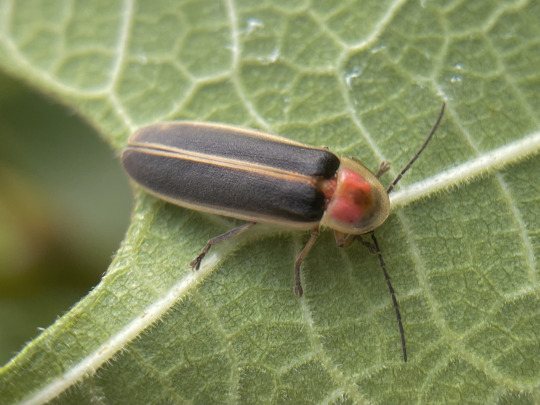
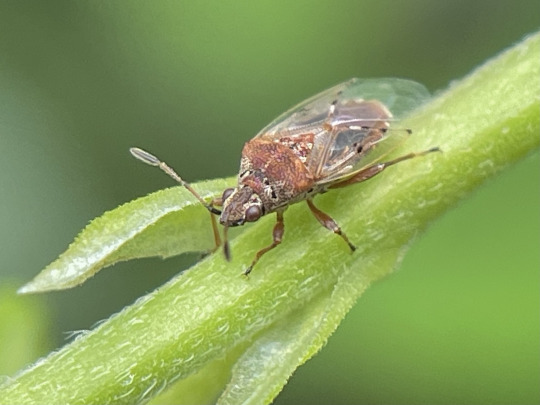
a few spare hemipterans: a Kleidocerys resedae that blew in on a wind, and below, the mulberry whitefly Tetraleurodes mori feeds on its namesake host. as for Hymenoptera, I saw manny tiny parasitic braconid wasps and various ants attracted to the planthoppers’ honeydew excretions—always worth checking underneath roosting hoppers for things having a drink.

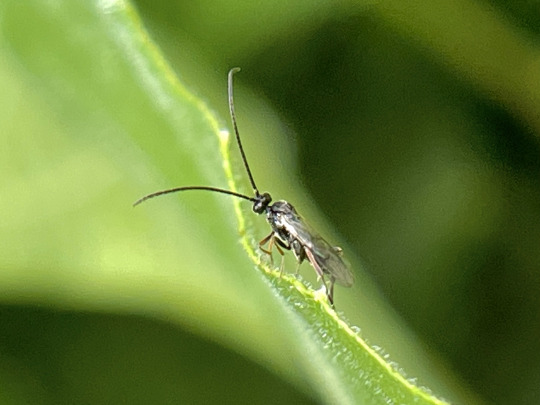
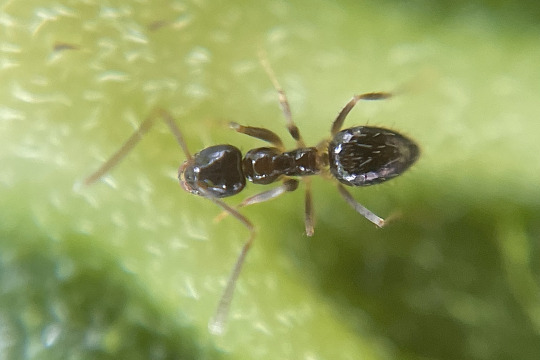
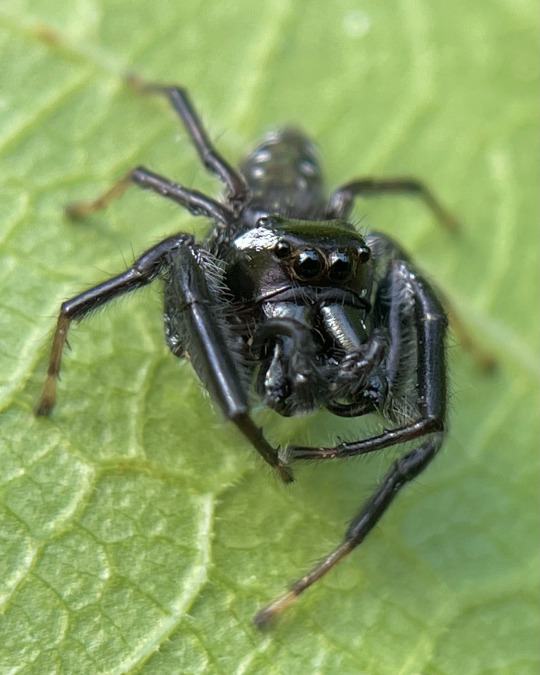
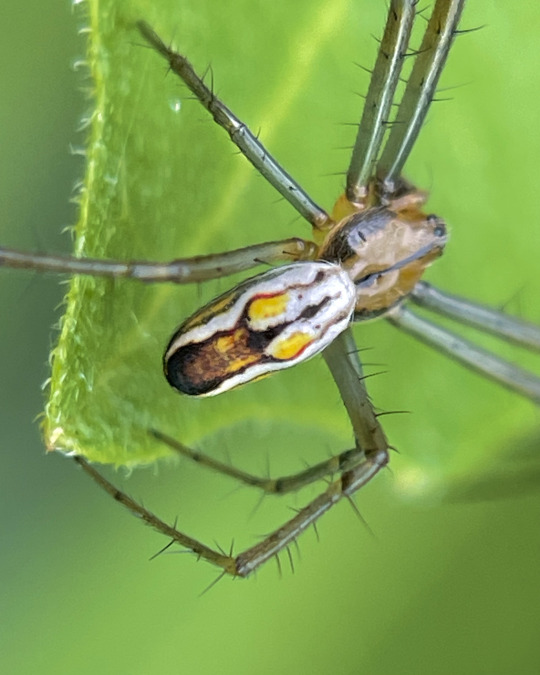
a couple handsome spider boys were scrambling through the fig seeking females, a jumping spider Paraphidippus aurantius and an orbweaver, Mecynogea lemniscata.
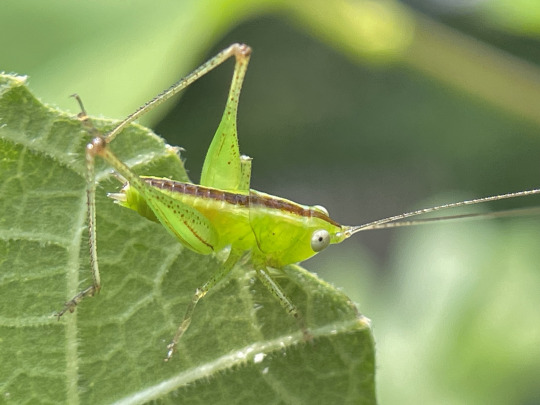
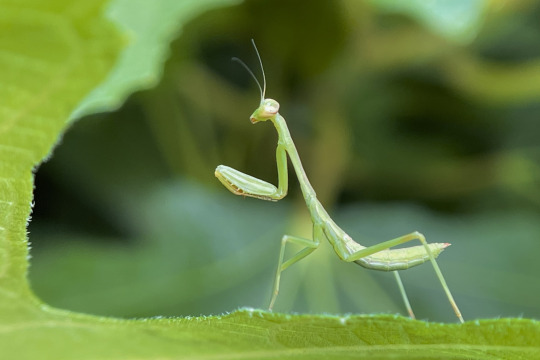
and to round it off, a young Conocephalus meadow katydid and a Carolina mantis, Stagmomantis carolina.
there’s 31 species of arthropod in this post, and I probably saw some 45, not all of which stayed for photos. if you walk slowly and look closely, you can see a sizeable chunk of your local biodiversity in under fifteen minutes! of course this will depend on where you live and what time of year it is, but there’s almost always more cool bugs out there than you’d expect, even on just a single plant.
1K notes
·
View notes
Text


What I believe is Leucophenga varia, a species of fruit fly that eats mushrooms, and think it just laid eggs there... I appear to be wrong it's likely to be some species of the Lauxaniid Flies Family (Lauxaniidae... spp)
#nature#my photography#fly#nature photography#wildlife photography#insect eggs#backyard nature#insect
9 notes
·
View notes
Text
#2439 - Sapromyza sp.

A genus of over 300 species of Lauxaniid flies, found over much of the world. Many species have tinted or vividly patterned wings.
Mangorei, Taranaki, New Zealand.
0 notes
Text
Calliopum genus


Look at this eyes
9 notes
·
View notes
Photo

Dotted Wing Lauxaniid Fly (Homoneura sp ) by trefore http://ift.tt/2x59JOo #macro
#nature#macro#outdoor#close-up#leaf#fly#garden#insects#colourful#supermacro#extreme macro#Australia#Q
0 notes
Photo

Before I forget about this experience completely, I thought I'd share the softbutts.
These flies were quire numerous in the sweep samples, and instead of keying them out, I just gave them a gross nickname, based on their funky soft abdomen. this past Friday I finally figured out what they were- Lauxaniid flies. Now to go back through and add all those labels!
I guess telling this story isn't nearly as funny as it was to type 'softbutt' on the data sheet. I'm 12.
7 notes
·
View notes
Text


Photo 1 - specimen 1, Photo 2 - specimen 2
Lauxaniid flies.
12/07/23 - Lauxaniidae: Homoneura laticosta - in town
#Homoneura laticosta#Lauxaniidae#Lauxaniid Flies#Brachycera#Brachyceran Flies#Diptera#flies#Insecta#Insects#arthropods#arthropoda#inverts#invertebrates#invertblr#insects tw#insectblr#bugs#bugs tw#bugblr
10 notes
·
View notes
Text
#2438 - Poecilohetaerus punctatifacies

A Lauxaniid fly endemic to Aotearoa. Others in the genus are found in Australia and New Caledonia.
Lauxaniids are most diverse in the tropical forests of Asia and the Americas, and the larvae feed in soil, bird nests, inside fallen leaves, rotten wood, and in flowers.
Mangorei, Taranaki, New Zealand
0 notes
Text
#1225 - Homoneura sp - Lauxaniid Fly

Small, brightly coloured flies mostly often found sitting quietly in woodland, often with patterned wings. Most Lauxaniids are saprophagous, eating leaf litter, bird nests, and so on. A few are leaf miners, or eat rotting wood, or plant buds. I don’t have anything specific on this genus.
Aubin Grove, Perth
5 notes
·
View notes
Text
#737 - Depressa sp. - Beetle-like Fly

A tiny Lauxaniid fly that landed on a gum just long enough for me to take a shot. These flies are highly unusual in that at rest the wings are bent around the body, like the wing-covers of a beetle, or some true bugs, inside of keeping them flat like most flies. I don’t know if they flatten out when the fly takes off, but they probably do - i can’t think of any insects that use curved wings when flying.
I don’t have any info on diet or biology.
Alcoa Wellard Wetlands, Perth
6 notes
·
View notes
Text
#268 - Lauxaniid Fly

Spotted on a fig on my last day in Uranquinty. Being pink, orange, and rotund puts it straight into the Lauxaniidae, a large family of acalyptrate flies. According to Wiki :
They generally are small flies (length 5 mm or less) with large compound eyes that often are brightly coloured in life. Many species have variegated patterns on their wings, but in contrast they generally do not have variegated bodies.
Some 1800 species of Lauxaniidae have been described and they comprise some 126 genera. The family has a cosmopolitan distribution, most of the species occurring in tropical regions of Asia and the Americas; relatively few species occur in Afrotropical regions, and Lauxaniid species diversity declines strongly towards the more temperate regions; for example fewer than 200 European species have been described. Most species inhabit forests, where the adults usually are found sitting on leaves of the understory. They are far less common in open country, such as grassland habitats.
The larvae are mostly saprophagous, feeding in leaf litter, soil, bird nests, etc.
#Lauxaniid#Acalyptratae#acalyptrate#fly#acalyptrate fly#Lauxaniidae#diptera#dipteran#insect#Uranquinty
3 notes
·
View notes